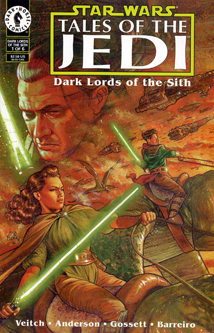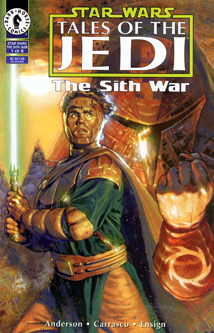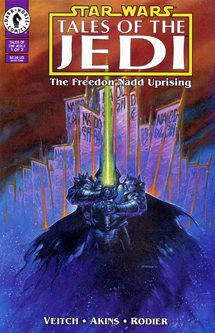


When I first saw “Episode I — The Phantom Menace,” I was a bit disappointed that the Emperor was already, for all intents and purposes, the Emperor — he was already evil. As the prequels went on we learned how he gained power over the galaxy, but not why he sought that power. Certainly, the novel “Darth Plagueis” eventually filled in Palpatine’s backstory, and certainly, the prequels gave us Anakin’s fall to the dark side (facilitated by Palpatine), but it illustrated a common not-so-great trend in “falls to the dark side” in “Star Wars”: It’s too often a matter of plotting more so than characterization.
I looked at “Tales of the Jedi’s” first five issues, which introduced us to Jedis Ulic Qel-Droma and Nomi Sunrider, in a previous flashback segment. And in a later post, I’ll look at “Redemption,” which is on my short list of greatest “Star Wars” comics ever. In between are three arcs that explore multiple characters’ falls to the dark side: “The Freedon Nadd Uprising” (two issues, 1994), “Dark Lords of the Sith” (six issues, 1994-95) and “The Sith War” (six issues, 1995-96).
Writers Tom Veitch and Kevin J. Anderson give us three distinct falls to the dark side:
- Cousins Aleema and Satal Keto are sociopaths who seek out Sith knowledge and subjugate the entire Empress Teta System largely on the strength of Aleema’s ability to create Sith illusions.
- Exar Kun already has some darkness in him, according to his master Vodo Siosk-Baas. And like the Ketos, he is curious about Sith history. Although this curiosity is probably driven more by a thirst for power than by any sense of altruism, he’s not sociopathic. When retrieving Sith scrolls from Freedon Nadd’s tomb, the spirit of Nadd purposely injures Kun and takes the light side of the Force away from him, forcing him to use the dark side to heal himself. Even then, Kun privately vows that it was a one-time-only deal; however, the light side is shut off to him, so he begins using the dark side. He kills a couple of good guys, mutters the usual “What have I done!?” and he’s off on his dark path.
- Ulic Qel-Droma does the same thing Luke Skywalker does in “Dark Empire.” Against the (very wise, it turns out) advice from elder Jedis, he decides to infiltrate the Sith kingdom of the cousins, planning to get in their good graces in order to learn all their secrets and defeat them and the Sith once and for all. As one of his first steps, he does something similar to Anakin killing the younglings in “Episode III”: He stops a citizen rebellion — killing many innocents — in order to keep the Ketos in power, thus gaining their trust. Next, Satal sticks him with a Sith poison, which essentially forces Ulic to embrace the Dark Side. Similarly, Exar Kun gains loyal followers by smashing a Sith Holocron near them, thus magically turning good guys into bad guys.

There’s lots to like about these 14 issues: Primary artist Chris Gossett and various colorists continue to bring “ancient” “Star Wars” to vibrant life by slightly calling to mind ancient Egypt (although not to the somewhat over-the-top degree we’ll see in the two “Tales of the Jedi” prequel arcs that were released after these arcs — “Golden Age of the Sith” and “Fall of the Sith Empire”). Adding to the rich, historic feel, these stories are filled with scrolls, holocrons, amulets and alchemy, and the Jedi library on Ossus is a pivotal setting — it’s almost like “Star Wars” meets “Indiana Jones.” Probably because of deadline issues, “Dark Lords of the Sith” No. 6 is drawn by Art Wetherell, who has more of a straight-ahead superhero comic style where all the characters look the same. The simplistic art highlights how simplistic — almost cartoony — the story is, and it suggests that Gossett’s art infuses the story with stylistic flair it doesn’t otherwise possess.

Although Aleema and Satal are simple characters, their misdeeds make for fun, disgusting reading, such as when Aleema makes her servant imagine he is vomiting up a serpent. Exar Kun, in one of the earliest examples of brand synergy, is given his backstory here; we already knew his future story as a spirit haunting the Yavin temples in Anderson’s “Jedi Academy Trilogy.” And Ulic, although following the same ill-advised path as Luke, gets a contrasting result: He goes much too far down the dark path, even killing his brother, Cay.
All that having been said, I can’t shake the feeling that I read 14 issues exploring Jedis and Sith without getting a good sense of what causes a person to turn from good to evil: The cousins were already evil, and Kun and Qel-Droma — and all of Kun’s followers — were mostly forced into it by Sith magic, as if they weren’t entirely in control of their own actions. While Anakin was certainly manipulated by Palpatine, George Lucas doesn’t give him an excuse like these writers do with Exar and Ulic: It’s quite clear that Anakin is making his choices on his own — they are bad, ill-informed choices, but they come from old-fashioned brain synapses, not from outside magic.

Interestingly, Veitch and Anderson introduce us to two Sith ghosts — Freedon Nadd and Naga Sadow (the latter of which gets his backstory in the “TOTJ” prequels). In the films, of course, it was only the good guys (Yoda, Obi-Wan, a redeemed Anakin, and — as we learned in “Episode III” — Qui-Gon) who could experience life after death in this way. In many yarns, Sith have been portrayed as striving desperately to extend their mortal lives because they fear death: In “The Clone Wars,” Darth Maul survives being cut in half; in “Dark Empire,” the Emperor is able to transfer his spirit into clone bodies; and in “Darth Plagueis,” the title character looks to discover immortality through science, continuing the work of his master, Darth Tenebrous.
The existence of Sith spirits in Veitch’s and Anderson’s work isn’t necessarily apocryphal; after all, every sentient is different. But it is interesting that Exar Kun, when faced with a battle he’s doomed to lose at the end of “The Sith War,” chooses to take steps to make himself a spirit. That is, in a way, a form of immortality — and arguably, it’s just a means to an end, as Kun does resurrect himself corporeally in the “Jedi Academy Trilogy.” But it also blurs the line between Sith and Jedi ways.
In the end, Ulic (and to some extent, Exar Kun) rather bluntly learns the lesson his masters tried so desperately to teach him: You can’t do good by doing bad. And that’s not a bad theme. However, I feel like Veitch and Anderson cheated a little bit by shooting Sith poison into Ulic rather than getting inside his head and telling a more challenging story.

